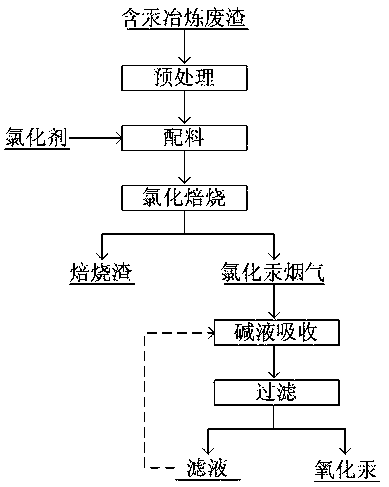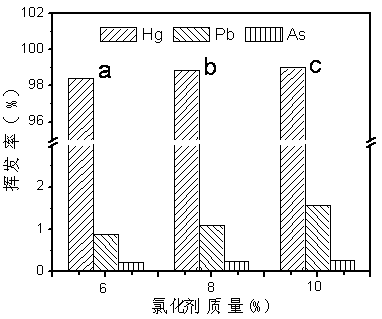Method for selectively recycling mercury from smelting waste residue
A selective and waste-residue technology, applied in the direction of improving process efficiency, etc., can solve the problems of metal ions entering the solution, complex components of crude mercury, and difficult refining, and achieve short process flow, low mercury content requirements, and wide application range Effect
- Summary
- Abstract
- Description
- Claims
- Application Information
AI Technical Summary
Problems solved by technology
Method used
Image
Examples
Embodiment 1
[0031] The smelting waste residue used in this example is lead smelting acid mud, after dehydration, the content of mercury is 5.24%, the content of lead is 13.42%, and the content of arsenic is 0.86%. Mix 250g of mercury-containing acid mud with 15g of sodium chloride evenly, that is, the mass fraction of sodium chloride is 6%, and put it in a tube furnace for chlorination roasting, the heating rate is 5°C / min, and the heating end temperature is 350 ℃, the holding time is 1h, and O 2 The volume fraction is 55%, and the gas flow rate is 0.02m / s. The result analysis found that the mercury content in the acid mud before and after the reaction decreased from 5.24% to 0.083%, the volatilization rate of lead was 0.87%, the volatilization rate of arsenic was 0.23%, and the volatilization efficiency of mercury reached 98.42% (such as figure 2 shown in column a).
Embodiment 2
[0033] The smelting waste residue used in this example is lead smelting acid mud, and the mercury content after dehydration is 5.24%. Mix 250g of mercury-containing acid mud with 20g of sodium chloride evenly, that is, the mass fraction of sodium chloride is 8%, and place it in a tube furnace for chlorination roasting, the heating rate is 5°C / min, and the heating end temperature is 350 ℃, the holding time is 1h, and O 2 The volume fraction is 60%, and the gas flow rate is 0.02m / s. The result analysis found that the mercury content in the acid mud before and after the reaction decreased from 5.24% to 0.059%, the volatilization efficiency of mercury reached 98.87%, the volatilization rate of lead was 1.09%, and the volatilization rate of arsenic was 0.25% (such as figure 2 shown in column b).
Embodiment 3
[0035] The smelting waste residue used in this embodiment has a mercury content of 5.24% after dehydration. Mix 250g of mercury-containing acid mud with 25g of sodium chloride evenly, that is, the mass fraction of sodium chloride is 10%, and place it in a tube furnace for chlorination roasting, the heating rate is 5°C / min, and the heating end temperature is 350 ℃, the holding time is 1.2h, and O 2 The volume fraction is 60%, and the gas flow rate is 0.02m / s. The result analysis found that the mercury content in the acid mud before and after the reaction decreased from 5.24% to 0.052%, the volatilization rate of lead was 1.57%, the volatilization rate of arsenic was 0.26%, and the volatilization efficiency of mercury reached 99.01% (such as figure 2 shown in column c).
PUM
 Login to View More
Login to View More Abstract
Description
Claims
Application Information
 Login to View More
Login to View More - R&D
- Intellectual Property
- Life Sciences
- Materials
- Tech Scout
- Unparalleled Data Quality
- Higher Quality Content
- 60% Fewer Hallucinations
Browse by: Latest US Patents, China's latest patents, Technical Efficacy Thesaurus, Application Domain, Technology Topic, Popular Technical Reports.
© 2025 PatSnap. All rights reserved.Legal|Privacy policy|Modern Slavery Act Transparency Statement|Sitemap|About US| Contact US: help@patsnap.com



